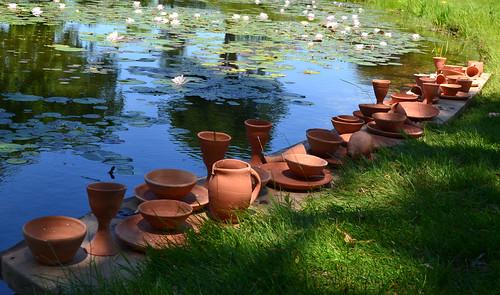2014 UWM Art Education Institute: Living Matter
July 7-11 & July 18, 1:30 pm-5:15 pm
Registration: Participants have the option of enrolling for 1 credit as either an undergraduate or graduate student through the University of Wisconsin-Milwaukee. Contact graduate representative for art education Rina Kundu at kundu@uwm.edu for further information. Registration is now closed. If you are interested in receiving information about the 2015 Summer Institute, please contact Prof. Rina Kundu at kundu@uwm.edu.
The UWM Art Education Institute at the Lynden Sculpture Garden welcomes K-12 teachers, community and museum educators, and docents with an interest in developing an interdisciplinary and integrated curriculum that explores the relationship between art and nature. Generalist teachers and those with expertise in science, language and social studies, as well as the arts, are encouraged to participate.
The idea of matter is central to physics, biology, and art. Even in the purely physical sense, we know that matter is never static, but mutable and relational. In this summer's institute, we will view the Lynden Sculpture Garden through the lens of Living Matter, exploring the idea that both the beholder and the works of art and nature that constitute the sculpture garden are situated, historical, physical bodies and because the boundaries among them are indefinite, they can affect and contaminate--even destroy--each other. By the end of the week, we will be thinking of Lynden less as an idealistic space showing an important collection of art in a natural environment, and more as a living and changing body.
Today’s knowledge and skills are more frequently constructed through mediatized processes and abstract concepts, and less often through first-hand experiences. We are expected to become passive consumers, and to see objects as mere commodities. To the extent that we are removed from the material experiences of making and experimenting with the manipulation of matter, we have become less reflective about the uses, relations, processes and states of being that objects facilitate, and the ways in which objects create complex entanglements between humans and the world we inhabit. It is here that the concept of materiality connects with the concept of embodiment--how our bodies perceive, understand, and represent their relationships with the external world, their intertwining and enfleshment. Philosopher Evan Thompson (2007) describes this as “the relation between one’s body as one subjectivity lives it and one’s body as an organism in the world” (p. 244).
These concepts of embodiment and materiality in relation to places and objects will provide the underlying structure for the summer institute. A toolbox of art-based strategies will be developed that will be augmented by a participatory, outdoor artmaking experience with guest artists. Participants will undertake a larger research and/or curriculum development project that they will present on July 18.
July 7-8
We will spend our time among Lynden's sculptures, spaces and landscapes engaged in guided, art-based exercises centered on Merleau Ponty’s (1962) concept of the world perceived as flesh and body, putting in practice strategies of material and spatial embodiment inspired by artists like Lygia Pape, Hélio Oiticica, Gabriel Orozco, Abbas Kiarostami and Richard Long.
July 9-11
We will collaborate with artists Linda Wervey Vitamvas and Kevin Giese on a site-specific transient installation on the Lynden grounds. Vitamvas and Giese have a relationship with Lynden that dates back to 2010 and the inaugural Inside/Outside exhibition, when both artists made interventions in the organism that is the sculpture garden. A ceramicist, Vitamvas, has produced a series of site-specific pieces that speak to transience, relationality, and the disintegration of materials back into the natural system of Lynden. Giese works with wood, and at Lynden he harvested, carved, and recontextualized living and dead buckthorn trees in an installation entitled Immigrant. Buckthorn is an invasive species introduced into this country from Europe in the mid-nineteenth century. “As a naturalist I lament the losses inflicted on our native habitat by these trees," says Giese. "As an artist I am intrigued by the dynamic between their visual beauty, strong resilient characteristics and their pariah status: unwanted, disliked, overlooked…Ultimately, it is we humans who are the invaders, dominating any landscape we occupy.”
July 18
We will reconvene to present our projects.


